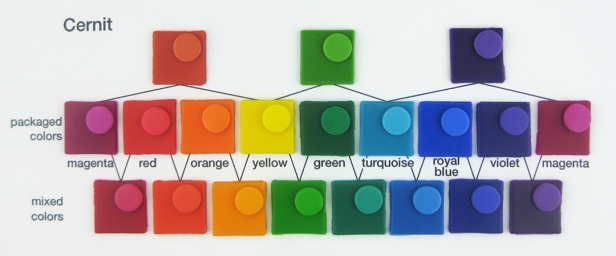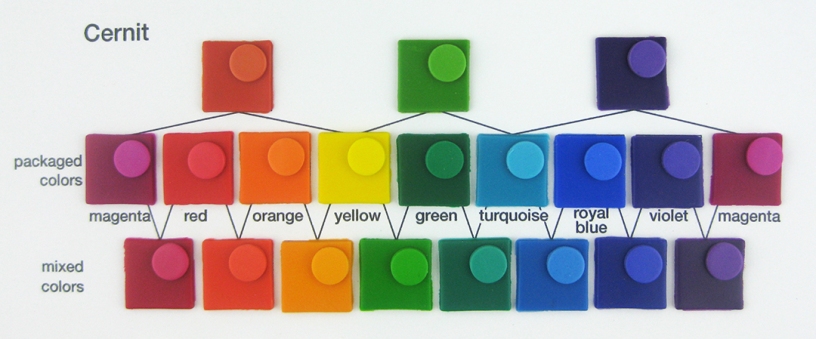
Cernit Number One offers a large color range. The colors are either 50% or 100% opaque, which is listed on the front label and on Cernit’s website.
The colors I used were 100% opaque except red, turquoise and violet which were 50%. You’d think the more translucent colors would shift the most, but that wasn’t the case.
I’ve found that the colors in the photo above, plus black and white, should be all that are needed to mix any color. I tested blue versus royal blue and prefer royal blue.
Cernit offers many other Number One colors. They also offer Shiny (with colored mica powder), Glamour (pearlescent or metallic), Nature (with inclusions), Neon, Doll and Translucent colors.
All of these swatches were baked at the manufacturer’s recommended temperature in two aluminum baking tins, one inverted as a lid with two small ceramic tiles inside.
CLAY FIRMNESS
Cernit is generally a firm clay that conditions fairly easily. Most colors were firm, some were crumbly. Translucent was soft. Generally, it isn’t sticky and is easy to work with.
MIXED COLORS
In the photo above, mixtures are indicated by lines drawn between colors.
In the top and bottom rows, I mixed colors that were visually halfway between the packaged colors in the second row. They weren’t mixed half and half because some colors are stronger than others.
The primaries of magenta, yellow and turquoise mix quite well to make secondary colors, as shown in the top row of the photo above.
WHITE & TRANSLUCENT


Opaque white is totally opaque. Porcelain white is 50% opaque. Translucent white is quite translucent. I find it second best in translucency compared to Pardo. My translucent white had hundreds of tiny bubbles it in when baked.
Opaque white stayed really white regardless of how long it was baked, and it didn’t break.
Translucent white stayed fairly light in color regardless of how long it was baked. See How to Avoid Plaquing in Polymer Clay. There was plaquing caused by the method of conditioning, rather than gas bubbles as seen in Fimo and Kato. See Which Polymer Clay Method Creates the Fewest Air Bubbles.
COLOR SHIFTING WHEN BAKED
When baked, all Cernit Number One colors darkened somewhat.
Colors that darkened the most:
- green
- turquoise
- royal blue
- magenta
- violet
Color that darkened a bit:
- red
COMPENSATING FOR COLOR SHIFTING

I compensated for color shifting by adding Cernit porcelain white or opaque white. Some came very close to the raw clay color. Others could use more white. Some yellow could be added to the green.

DOUBLE-BAKING HELPS CERNIT WHITE AND TRANSLUCENT
Only white and translucent Cernit seem to benefit from double-baking. See Double Baking to Avoid Plaquing in Polymer Clay.
White and translucent yellowed slightly when baked only once. See the photo below. Cernit had a few tiny bumps in the surface, but no big plaques. Plaquing didn’t seem any less with double-baking.


AVAILABILITY
I haven’t seen Cernit available in local retail stores. I order it online from The Clay Factory.
CONCLUSION
All Cernit Number One colors darkened somewhat when baked.
Colors that darkened the most:
- green
- turquoise
- royal blue
- magenta
- violet
Color that darkened a bit:
- red
This can be corrected with some white. White or yellow can be added to green.
Translucent benefits some by double-baking.
Cernit Number One is generally a firm clay that conditions fairly easily. It isn’t sticky and it’s easy to work with.
Official company site: http://www.clay-and-paint.com/en/
P.S. I bought all these products myself and received nothing from the manufacturers.


Thank you!
LikeLike
I wish I had read this before I did a bunch of earrings last night with a magenta leopard print (Cernit). They came out not at all as popping as before they went in the oven. 😦
I used Cernit many years ago and knew that the colors darken but I just forgot.
Anyway, thank you for your hard and thorough work with this page, it’s a huge help!
LikeLike
Yes, that happens. Thanks for writing!
LikeLike